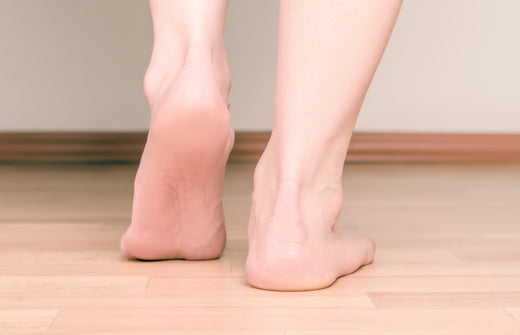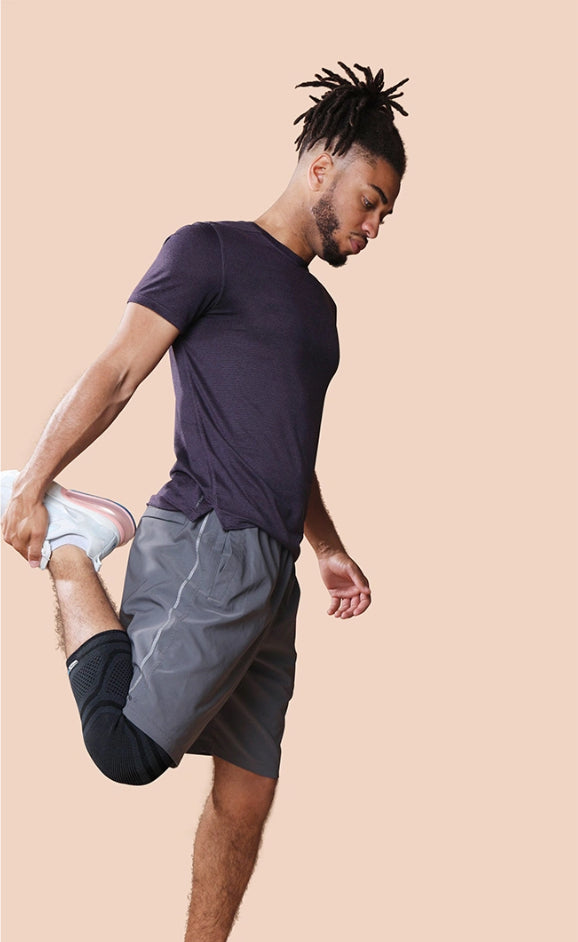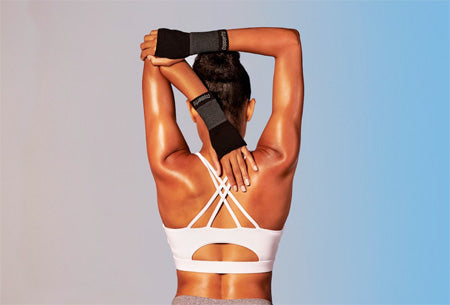
Flat feet are sometimes called fallen arches or pes planus.If you have flat feet, it means the arch of your foot is either significantly smaller than normal or not visible at all. This common condition can affect one or both of your feet — for many people, both arches are fallen.
Here’s everything you need to know about flat feet and how to determine if you have them.
What Are the Different Types of Flat Feet?
There are two main types of flat feet: rigid flat feet and flexible flat feet. Here’s what you need to know about each:
Rigid Flat Feet
Sometimes called tarsal coalition, rigid flat feet have no arch at all times, no matter what position you’re in. That means if you have rigid flat feet, your feet are flat whether sitting, standing, or even on tiptoes.
Unlike flexible flat feet, rigid flat feet are usually present from birth. In addition, both feet are typically affected rather than just one. If you have rigid flat feet, you’ll probably notice limited flexibility in your feet and a lower range of motion.
Rigid flat feet typically cause all of the following symptoms:
- Ankle pain
- Aching legs and feet
- Limited range of motion
- Trouble standing on tiptoe
- Changes in gait
Flexible Flat Feet
Flexible flat feet are another common type that can cause similar problems. However, flexible flat feet only become “flat” (the arch diminishes) when bearing weight. In other words, when a person with flexible flat feet is standing, the condition takes effect. When they are sitting or lying down, it doesn’t.
Flexible flat feet can cause many of the same symptoms as rigid flat feet, including:
- Pain and swelling
- Limited range of motion
- Trouble standing on tiptoe
- Sore heels
Unlike rigid flat feet, flexible flat feet often develop during adolescence or adulthood. Some of the best treatments for the condition are simple lifestyle changes like stretching or wearing more supportive shoes.
How Do You Test for Flat Feet?
If you’re wondering whether you have flat feet, visiting the podiatrist is the best place to start. Either a podiatrist or other orthopedic specialist can evaluate your feet using several forms of testing to determine whether you have fallen arches.
Testing methods for flat feet include:
- MRI
- CT Scan
- X-Ray
Visiting a podiatrist can be especially helpful when dealing with persistent foot pain. In addition, a podiatry specialist can prescribe several different treatment options to help you deal with the symptoms of flat feet. They might also point you to over-the-counter treatments like orthotics or arch supports.
If you’re not experiencing major pain and just want to know whether you have flat feet, there are a few at-home evaluations you can try, including:
- A self-examination
- Checking for common symptoms
Self-Examination for Flat Feet
You can examine your feet at home to see if you can spot some of the telltale signs of flat feet. Here’s how:
While standing up, look down at your feet. You should be able to see a small arch on the inside of your foot while standing in your normal stance. If there’s no arch present, this is a sign that you might have flat feet.
You can also try the wet footprint test to determine whether you have flat feet. To do this test, get your feet slightly wet. Then, step onto a surface where your feet will leave a mark, such as a tiled floor.
Your footprint should include the inward curve of your foot’s natural arch. If you instead see an imprint of the entire bottom of your foot, you may have flat feet.
Checking for Common Symptoms
Not everyone with flat feet notices any signs or symptoms. However, if you spot any of these common symptoms, it’s worth visiting the podiatrist:
- Lower back pain
- Frequent shin splints
- Aching Achilles tendons
- Frequent foot fatigue
These symptoms can stem from a variety of different issues, so it can be hard to determine the underlying cause without help from an expert. If you’re dealing with any of the symptoms listed above, mention them to your primary care doctor or a podiatry specialist.
Can Flat Feet Cause Problems?
Flat feet can cause a few mild to moderate health issues, especially when left untreated for years. All of the following issues can be caused or worsened by the absence of a foot arch:
-
Flat feet can cause pain. This foot problem is usually most noticeable because it makes your feet and legs uncomfortable. You might notice pain in your heels, ankles, or along the edges of your feet. The pain caused by flat feet is typically a dull ache rather than sharp or radiating. It’s no cause for major concern but still warrants a visit to an orthopedic professional.
-
Flat feet can make you tired. If you’re experiencing fatigue after walking, running, or other types of exercise, flat feet are one of the most common causes to consider. One key sign of flat feet is a tendency to notice aches and pains in your feet after exercise. Remember, however, that everyone’s feet get tired after a tough workout.
- Flat feet can cause problems with ankle and knee alignment: If flat feet aren’t addressed, they can cause your ankles and knees to become misaligned, leading to discomfort and pain. Alignment issues like these can sometimes make a person more prone to ankle injuries.
If you have flat feet, there’s no need to be seriously concerned. Many people with flat feet don’t experience foot pain, back pain, or other issues associated with the condition. Factors like age, weight, occupation, and more can influence how much flat-footedness interferes with your day-to-day life.
What Are the Big Risk Factors for Flat Feet?
So, why do flat feet develop?
There are several factors that can make you more likely to lose the normal arch in your feet over time. Some of the most common causes of flat feet are:
-
Certain health conditions: Diabetes, rheumatoid arthritis, and certain genetic conditions, such as cerebral palsy or muscular dystrophy, can cause flat feet in some cases.
-
Injuries: If you’ve sustained a lot of foot and ankle injuries, it’s possible that the tendons in your ankles could be damaged. Over time, injuries like these can lead to knee pain, heel pain, and flat feet.
-
Pregnancy: Your body goes through a lot of changes while you’re carrying a baby, and it’s possible that even your feet might be affected.
-
Genetics: You might have inherited flat feet, as well as other foot health problems, from your parents. This condition, along with plantar fasciitis, bunions, and more, can all be hereditary.
- Weight: If your BMI falls in the obesity range, you may be at a higher risk for developing flat feet.
Are Flat Feet Treatable?
If you’re experiencing pain, fatigue, and posture problems due to flat feet, rest assured, knowing you can find the relief you need! Flat feet are treatable, but the treatment that’s right for you will depend on the underlying cause.
Below are some of the most common and reliable treatments for flat feet:
-
Physical Therapy: One of the best ways to address flat feet is with the help of a licensed physical therapist. Your physical therapist will recommend exercises, stretches, and lifestyle changes that can help you get relief from aches and pains caused by flat feet. In addition, a physical therapist can help you stick to healthy habits that keep your symptoms to a minimum.
-
Orthotics and Other Shoe Inserts: Orthotics and other shoe inserts can be life-changing if you’re dealing with foot fatigue and posture issues due to flat feet. Some of the best options include built-in orthotics for support and insoles for extra comfort.
-
Lifestyle Changes: One of the most common causes of adult-acquired flatfoot is obesity. If you’re struggling to get relief, talk to your doctor about your current weight to see if losing weight might be beneficial.
- The Right Shoes and Socks: As you can imagine, wearing the wrong shoes and socks can make your flat feet symptoms worse. We recommend cushioned performance socks, keeping your feet nice and comfy, and a pair of breathable shoes that fit well.
The Bottom Line
If you have flat feet, there’s plenty of hope for relief. After you’ve determined that you have either rigid or flexible flat feet, talk to your doctor about treatment options for flat feet that might work best for you. Custom orthotics can be helpful in many cases, as they’re designed to support your feet and provide contoured arch support.
In addition to trying orthotics, consider paying a visit to a local physical therapist. Physical therapy can help you retrain your posture to put less weight on the arches of your feet and give you a set of helpful exercises to promote flexibility and minimize pain.
Overall, flat feet are very manageable in most cases. When you have the right tools and some good habits, you can get major relief over time.
Sources:
Flatfeet - Symptoms and causes | Mayo Clinic
What To Know About Flat Feet | Medical News Today
Flat Feet (Flatfoot): Types, Causes & Treatment | Cleveland Clinic





